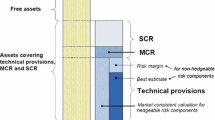Abstract
Problems of computational actuarial mathematics, dynamic financial analysis, and optimization of insurance business and the possibility of their solution by means of parallel computing on graphics accelerators are discussed. The ruin probability and other performance criteria of an insurance company are estimated by the Monte Carlo method. In many cases, it is the only applicable method. Since the ruin probability is small enough, to achieve an acceptable estimate accuracy, an astronomical number of simulations may be required. Parallelization of the Monte Carlo method and the use of graphical accelerators allow us getting the desired result in a reasonable time. The results of numerical experiments on the developed system of actuarial modeling are presented, allowing the use of graphical accelerator that supports Nvidia CUDA 1.3 and higher.
Similar content being viewed by others
References
B. de Finetti, “Su un’impostazione alternativa della teoria collettiva del rischio,” in: Trans. 15th Intern. Congress of Actuaries, 2, New York (1957), pp. 433–443.
H. Schmidli, Stochastic Control in Insurance, Springer-Verlag, London (2008).
N. L. Bowers, H. U. Gerber, J. C. Hickman, D. A. Jones, and C. J. Nesbitt, Actuarial Mathematics, Society of Actuaries, Itasca (1997).
V. Yu. Korolev, V. E. Bening, and S. Ya. Shorgin, Mathematical Fundamentals of Risk Theory [in Russian], Fizmatlit, Moscow (2011).
M. M. Leonenko, Yu. S. Mishura, Ya. M. Parkhomenko, and M. J. Yadrenko, Probability-Theoretical and Statistical Methods in Econometrics and Financial Mathematics [in Ukrainian], Informtekhnika, Kyiv (1995).
C. D. Daykin, T. Pentikainen, and M. Pesonen, Practical Risk Theory for Actuaries, Chapman and Hall, London – New York (1994).
J. L. Teugels and B. Sundt (eds.), Encyclopedia of Actuarial Science, Wiley, Chichester (2004).
R. Kaufmann, A. Gadmer, and R. Klett, “Introduction to dynamic financial analysis,” ASTIN Bull., 31, No. 1, 213–249 (2001).
P. Blum and M. Dacorogna, “DFA — dynamic financial analysis,” in: J. L. Teugels and B. Sundt (eds.), Encyclopedia of Actuarial Science, Vol. 1, Wiley, Chichester (2004), pp. 3342–3355.
M. R. Hardy, “Dynamic financial modeling of an insurance enterprise,” in: J. L. Teugels and B. Sundt (eds.), Encyclopedia of Actuarial Science, Vol. 1, Wiley, Chichester (2004), pp. 3618–3628.
B. Norkin, “Parallel computations in insurance business optimization,” in: Proc. 1st Intern. Conf. on High Perform. Comput. (Oct. 12–14, 2011, Kyiv), Kyiv (2011), pp. 33–39.
B. V. Norkin, “Paralleling of the methods of insurance company bankruptcy risk assessment,” in: Teoriya Optym. Rishen’ [in Ukrainian], V. M. Glushkov Inst. of Cybernetics NANU, Kyiv (2010), pp. 33–39.
B. V. Norkin, “Ruin probability of a controlled autoregression process,” in: Komp. Matematyka [in Ukrainian], V. M. Glushkov Inst. of Cybernetics NANU, Kyiv (2011), pp. 142–150.
B. V. Norkin, “Actuarial computing with the use of graphic processors,” in: Trans. Intern. Conf. on High Performance Computing (HPC-UA 2012, Kyiv, October, 10, 2012), NANU, Kyiv (2012), pp. 268–274.
B. V. Norkin, “On performing actuarial calculations on GPU,” in: Visn. NTUU “KPI,” Inform., Upravl. ta Obchysl. Tekhn., Zb. Nauk. Prats’, No. 56 (2012), pp. 113–119.
A. V. Boreskov, A. A. Kharlamov, N. D. Markovskii et al., Parallel Computing on GPU. CUDA Architecture and Program Model [in Russian], Izd. Mosk. Univer., Moscow (2012).
B. V. Norkin, “Mathematical models for insurance optimization,” Cybern. Syst. Analysis, 47, No. 1, 117–133 (2011).
B. V. Norkin, “Insurance portfolio optimization,” Prikl. Statistika. Aktuar. ta Fin. Matem., No. 1–2, 197–203 (2011).
G. B. Dantzig, “Need to do planning under uncertainty and the possibility of using parallel processors for this purpose,” Ekonom.-Mat. Obzor, 23, 121–135 (1987).
G. B. Dantzig and P. W. Glynn, “Parallel processors for planning under uncertainty,” Ann. Oper. Res., 22, 1–21 (1990).
Wu. Haizhen, “Parallel computing using GPUs,” March 1, 2011, http://ecs.victoria.ac.nz/twiki/pub/EResearch/EcsTeslaResource/Parallel.Computing.Using.Graphics.Cards.pdf.
Li J., Hu X., Zhanlong Pang Z., and Qian K., “A parallel ant colony optimization algorithm based on fine-grained model with gpu-acceleration,” Intern. J. Innov. Comput., Inform. and Control, 5, No. 11(A), 3707–3716 (2009).
E. A. Nurminskii and P. L. Pozdnyak, “Solving the problem of searching for the least distance to a polytope with the use of graphical accelerators,” Vychisl. Tekhnol., 16, Issue 5, 80–88 (2011).
Law of Ukraine “On insurance,” Vidom. Verkh. Rady Ukrainy, No. 18, p. 78 (1996), http://zakon1.rada.gov.ua/laws/show/85/96-Bp.
A. I. Zaletov, Insurance in Ukraine [in Russian], Intern. Agency “BeeZone,” Kyiv (2002).
A. Nakonechnyi, “Optimization of risk processes,” Cybern. Syst. Analysis, 32, No. 5, 641–646 (1996).
P. Cízek, W. Hardle, and R. Weron (eds.), Statistical Tools for Finance and Insurance, Springer, New York (2005).
H. R. Waters, “Some mathematical aspects of reinsurance,” Insurance: Math. Econ., No. 2, 17–26 (1983).
IBM ILOG CPLEX V12.1. User’s manual for CPLEX, Intern. Business Machines Corp. (2009).
W. Hoeffding, “Probability inequalities for sums of bounded random variables,” J. Amer. Statist. Assoc., 58, 13–30 (1963).
NVIDIA, CUDA CURAND Library (2010).
Intel Digital Random Number Generator (DRNG): Software Implementation Guide, http://software.intel.com/en-us/articles/intel-digital-random-number-generator-drng-software-implementation-guide/.
Author information
Authors and Affiliations
Corresponding author
Additional information
The study was partially supported by the grant of the President of Ukraine for the support of scientific studies of young scientists, No. GP/F49/121.
Translated from Kibernetika i Sistemnyi Analiz, No. 2, March–April, 2014, pp. 112–125.
Rights and permissions
About this article
Cite this article
Norkin, B.V. Systems Simulation Analysis and Optimization of Insurance Business. Cybern Syst Anal 50, 260–270 (2014). https://doi.org/10.1007/s10559-014-9613-9
Received:
Published:
Issue Date:
DOI: https://doi.org/10.1007/s10559-014-9613-9




